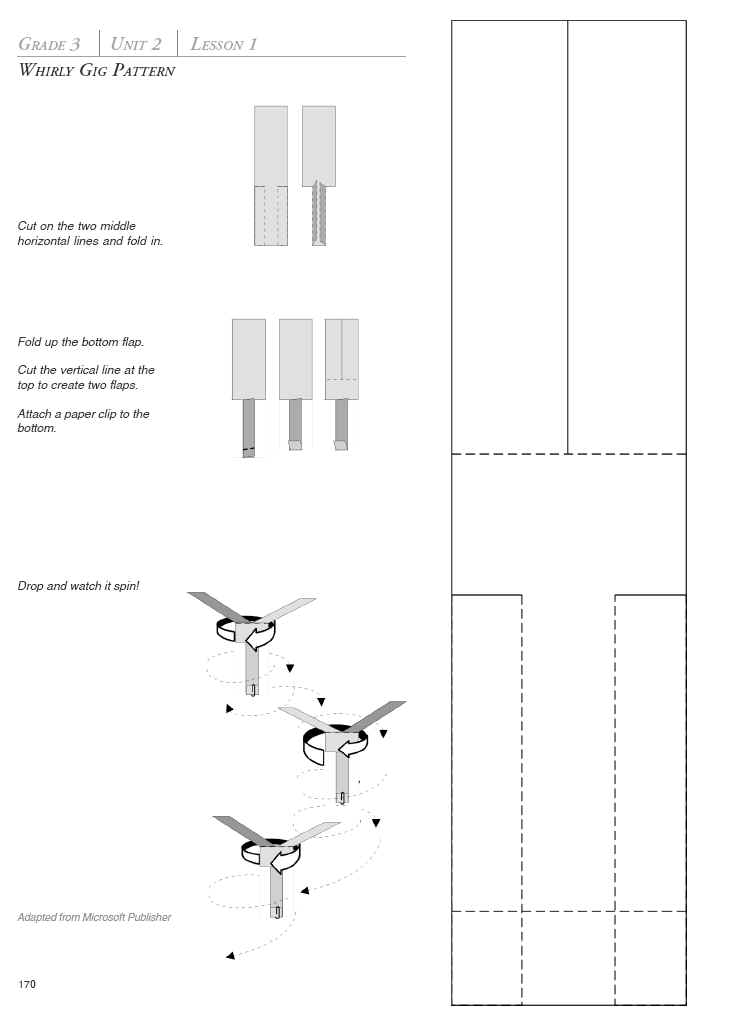G
ROWING PLANTS
IN THE GARDEN
Traveling Seeds LESSON
Content Objective: Understand
how seeds travel
Life Skill Objective: Learning
to learn through observing, experimenting, and
recording;
critical thinking
Indicator: Draw or write in
their journals how different seeds travel
Subjects: Science, language
arts
Materials: Assortment of
seeds to demonstrate how seeds travel (Milkweed,
Dandelion, Sticktight, Cocklebur, Burdock, Queen Anne.s
Lace, Maple, Ash, Elm, Coconut, Raspberry, Strawberry, Sunflower,
Corn kernels, Acorns)
Post-It. notes (one
per student)
Whirly Gig Pattern (one
per student, located on page 170)
Tub of water to float a coconut or
a bowl of water to float sunflower
seeds
Paper confetti to explode out of an envelope or small bag
Blank sheets of paper (one
per student)
Manila file folders (one
per student)
Large pair of old socks (brought
by the students to wear over their
shoes and pants)
Hand-held magnifying glasses
Folders for Growing in the Garden Journals
Evaluation (from
notebook pocket
Have you ever noticed an area where the soil was just turned or
tilled, then came back a couple
weeks
later and saw that weeds had begun to sprout? How did those weeds get there? The
plants did not walk, fly, swim, or
crawl to the bare soil, but their seeds got there somehow and began to grow.
If all plants simply dropped their seeds right below the “mother plant,” the
area would become too crowded and
most of the plants wouldn’t survive. Seeds move around in various ways.
DO
(15 minutes)
Teacher Note: Give
the students one Post-It. note each and have them stick it somewhere on
their clothes. Tell them that it will fall off somewhere in the classroom and
that they are to
leave it where it falls. Also have the Whirly Gig Patterns, tub or bowl of water
for coconut or
sunflower seeds, and confetti in the envelope or bag ready to use.
(Write
.hitchhiking seeds. on the board. Have the students walk around the room or move
in their chairs until
their sticky notes fall off.) Have
you ever been out for a walk in the woods or tall weeds during the
fall and you came home with hitchhiking seeds stuck on your socks, pants, and
shoestrings? Do you have a dog or
cat that has romped in the weeds until its fur became full of tangles
and seeds? Hitchhiking means
trying to get a ride from one place to another. Hitchhiking is
one way seeds move from one place to another. Your sticky note hitchhiked on
your clothes until it was brushed
off or fell onto the ground.
(Write .airborne seeds. on the board. Distribute the Whirly Gig
Patterns and follow the instructions to make
the
Whirly Gigs.) Have you seen seeds
such as dandelion or maple tree seeds floating in the air? Animals
carry a lot of seeds around from place to place, but more are carried in the
wind. When some seeds are ripe,
they fall off the tree or plant, spin and whirl, and are airborne or carried
away by the wind. Stand beside your desk
and hold your Whirly Gig way above your head. Then
watch it spin and whirl to the ground like an airborne seed.
(Write .floating seeds. on the board. Have the students stand
around the tub or bowl of water.)
Some
seeds float away from their parent plants.
Have you ever seen seeds floating in a puddle, along a
shore, or in a creek? Let’s see if this coconut or these sunflower seeds
float. (Have the
students try
floating the seeds.)
(Write .exploding fruits. on the board. Hold the envelope or bag
of paper with confetti up so everyone can see.)
Some
seeds explode out of their seed pod and scatter all over. The seed pods are like
loaded cannons. When the seeds
ripen and the pods dry, the pods split open with force, flinging the seeds
in all directions. Let’s imagine that this envelope or bag is a seed pod and
the seeds inside are ripe. We’ll
rip open this envelope and see where the seeds scatter.
A
N
IDEA
FROM HITCHHIKING
SEEDS
Have you ever had shoes, hats, gloves, or other things that
close with Velcro
™?
George de Nestral took
the idea from seeds and fruits that have hooks that cling to fabric
and fur and invented Velcro™!
REFLECT
(10 minutes)
Hitchhiking Seeds: How
are hitchhiker seeds like the sticky note you’ve been wearing
on your clothes? The sticky note was stuck on your clothes until it was brushed
off or fell somewhere. If it was a seed, the sticky note would have been planted
where it fell and it may have eventually grown a new plant.
Some hitchiker seeds
have hooks or stickers on them. Sticktights are small, flat fruits that
look like seeds. There is one
seed in each sticktight fruit. The fruit has sharp points or barbs that
hook into your clothes. If you pull
the sticktights off of your clothes while you are outdoors, you
have moved the seeds to a new location where they might grow. Animals move
the sticktights from place to
place on their fur.
The dried flower head of a burdock is a small ball that is covered with
stiff, sharp hooks. A burdock
burr is hard to get rid of because it sticks to your fingers when you pick
it off your clothes! They are
a real mess when they get tangled in hair and animal fur! The seeds of the
burdock are tucked inside the burr
and are scattered when the burr is broken.
Queen Anne’s Lace is a common weed
found in ditches. The small fruit on this plant has rows of
tiny spines or hairs. When it is ripe it gets stuck on the dry fur of
animals and is carried away.
A common lawn weed, plantain, moves its seeds in a strange way. When the
seeds that form on its tall
spike get wet on a rainy day, their outsides become sticky like jelly. The
jelly-covered seeds stick to
anything that brushes up against them. |
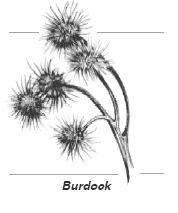 |
What other ways do seeds hitchhike with animals before the seeds
are planted? What do
squirrels do
with the acorns and nuts that they collect? They carry them away from the trees
and bury them. Some of these buried
seeds grow into large trees. What happens to the seeds after bears,
birds, raccoons, and other animals eat berries and fruits? The seeds pass
through their stomachs and are
spread in their scat or feces. Have you seen purple bird droppings that came
from a bird that ate berries?
Teacher Note: Picking up hitchhiking seeds
This is an
optional activity for fall or early spring. Have the children put an old pair of
large socks over their shoes
and pants, then have them walk through a patch of weeds. When they come out,
have them look at the
seeds on their socks under a magnifying glass. Ask them if they picked up any
.hitchhiking. seeds and if
they can see hooks, barbs, or spines. See if they can name the plants that the
seeds came from. Ask what
could happen if they brushed or picked the seeds off their socks and put them
back on the ground. Ask
the students why every seed won.t grow into a plant. The children should save a
few of the seeds from their
socks to add to their seed collections in APPLY.
Airborne Seeds: What
happened to your Whirly Gig when it floated in the air? What if you
added a little wind when you
released your Whirly Gig? Have you seen seeds floating in the air?
What plant did they come from?
The flowers of some plants such as dandelions and thistles dry so that
there is light, fluffy fuzz on the
ends of the seeds. This fuzz becomes a parachute that can carry a seed for
miles on a strong gust of
wind. Milkweed also spreads its seeds with fuzzy parachutes. Each milkweed
seed has about 900 silky
hairs that are light and hollow. When the milkweed pod splits, the wind
catches the fluffy hair and
pulls the parachute and seed out of the pod, sending it floating in the
breeze.
Some seeds have special wing-like parts that catch the wind and get
carried away. Maple, ash, and
elm trees have seeds that twirl in the air like helicopters. The seeds are
formed on branches high in
the tree. When the seeds are ripe, they fall off the tree, spin and whirl,
and are carried away by the
wind.
Some plants such as columbine and poppies have tiny seeds. Their pods
crack open when they are
ripe. When the wind blows, the seeds shake out of the pod and are blown
away. |
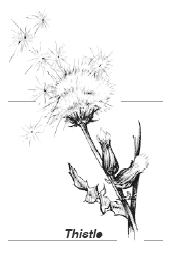 |
Floating Seeds: Did
our seeds float in the tub of water? What sources of water are there
outside where seeds might be
floating? During heavy rains, seeds are washed into ditches and float
until the water dries up and the
seeds grow where they are deposited.
Coconuts are sea travelers. The outside of a ripe coconut fruit is a
waterproof coat made of fiber and
air. The coat acts like a life preserver, allowing the coconut to float
instead of sink. When coconut
palm trees grow near the ocean, the coconuts may fall from the tree and
roll in. The coconuts float
until they are washed up on shore.
The lotus is a plant that grows in the water. It produces seeds in a flat
head or pod. When the seeds are
ripe, they fall into the water and float away until they find a good place
to grow. Water lilies also grow
in ponds and lakes. Their seeds float away in little cases of jelly. After
a while, the jelly melts. The
seeds fall to the bottom where they sprout and grow. Sometimes the seeds
are eaten by fish. If these
seeds are passed through the fish, they may be dropped far from the parent
plant. |
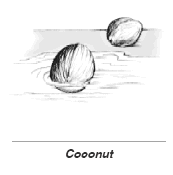 |
Exploding Fruits: What
happened to our confetti when we ripped open the envelope or bag? It
exploded and fell all over the
ground. Have you seen purple violets growing in your yard or garden?
Did you plant them there? Violet seeds explode and scatter several feet
from the parent plant when
the violet fruit splits open.
The touch-me-not is a small plant that grows in woodlands. The pod that
holds the seeds is made up of
strap-like pieces that are hooked together. The straps are like springs
that have been stretched as
far as they can go. The slightest touch or bump makes the pod explode and
sends the seeds sailing. This
is why they are called “touch-me-nots.” Brightly colored garden
impatiens also produce plump
fruit that burst open when touched.
Witch hazel is a large shrub that has exploding seed pods. Birds love to
eat the seeds and carry them away. |
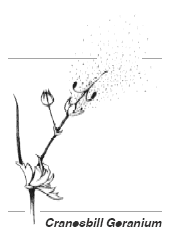 |
Teacher Note:
Ask
the students to take out a blank sheet of paper and fold it in half twice. Ask
them about the
four ways seeds travel. Have them write each of the ways at the top of the four
boxes on their papers. Refer
to the words written on the board. Have the students draw an example in each
box. This activity should
be put in their Growing in the Garden Journal folders.
APPLY
(10
minutes, and take-home
assignment)
How do people move seeds?
Consider gardeners, farmers, and seeds salespeople and
where/how they get seeds and where/how they plant seeds.
Have you moved any seeds? How did you do it? Where were they
planted? What grew from the seeds?
Give some examples of good things that could happen from
traveling seeds.
Give some examples of bad things that could happen from
traveling seeds. What happens when lots
of weeds grow in gardens or yards? Unwanted plants compete with our lawns,
flowers, and vegetables for food,
water, and air. What do people do with unwanted plants? It’s best to pull
weeds before new seeds spread.
How do people travel from place to place? (Make
a list on the board. Examples include walking, crawling,
running, and biking. People also ride in cars, trucks, airplanes, on trains,
bicycles, etc.)
Seed Collection:
Give
each student a manila folder to use for his/her seed collection. This is a
takehome assignment.
Instruct the students to find as many seeds as possible and glue them on the
folder. Remind
them that many of the foods we eat such as popcorn, rice, and beans are seeds.
Many of the fresh fruits
and vegetables we eat such as apples, strawberries, cucumbers, peppers, etc.,
have seeds in them.
The students should organize their seed collections by the way the seeds are
spread: air, water, wind,
animals, people, or dropped from the plant. You may want to invite a Master
Gardener, horticulturist, or
agronomist to talk to the class on how to find seeds. Give the students two
weeks to complete the project.
Then have them share their collections with the rest of the class.
• Where did you find most of the seeds in your collection?
• Are the seeds the same color, size, and shape?
• How did most of the collected seeds travel?
• Did you have any surprises? Did you learn something new?
Resources
Burne, David.
Eyewitness
Books: Plant.
N.Y.: Alfred A. Knopf, Inc., 1989. ISBN 0-394-82252-8.
Lauber, Patricia.
Seeds
Pop. Stick. Glide.
N.Y.: Crown Publishers, Inc., 1981. ISBN 0-517-54165-3.
http://www.extension.iastate.edu/GrowingintheGarden/pdf/travel.pdf
